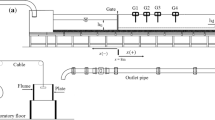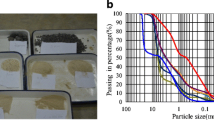Abstract
Sediment transport rate determination plays an essential role in mathematical models of embankment dam breaching. The sediment transport formulae commonly used today were mostly determined under considerably different conditions than those existing during the breaching of embankment dams, i.e. in connection with relatively mild longitudinal slopes. However, due to the scarceness of sediment transport relations for sediment transport rates on steep slopes, these traditional formulae are frequently used in dam breach modelling. This paper contains a description of a physical model of a 0.86 m high sandy dike constructed and breached at an outdoor laboratory operated by the Faculty of Civil Engineering, Brno University of Technology, Czech Republic. The dike shape and material were the same for all experiments. The used material was homogeneous non-cohesive medium-uniform sand. The results of the experimental breaching of the sandy dike were discussed and compared with sediment transport rates obtained from various empirical formulae. The comparison shows differences between experimental and calculated sediment transport rates which in all analysed cases indicate overestimation of the breaching rate calculated by empirical formulae.















Similar content being viewed by others
Abbreviations
- A :
-
Area of water surface in the upstream tank (m2)
- b :
-
Average breach width (m)
- C :
-
Friction coefficient (–)
- c :
-
Sediment concentration (–)
- c b :
-
Bed load concentration (–)
- D :
-
Mean particle diameter (m)
- D i :
-
The grain diameter corresponding to i % passing (m)
- d :
-
Water depth (m)
- Fr:
-
Froude number (–)
- g :
-
Gravitational acceleration (m/s2)
- h :
-
Water level in the upstream tank (m)
- I d :
-
Compaction index (–)
- k :
-
Roughness factor (k = 3D 90 for θ < 1; k = 3θD 90 for θ ≥ 1) (–)
- k r :
-
Roughness coefficient of bed-forms such as ripples (–)
- k s :
-
Manning–Strickler coefficient of roughness related to sand-grain surface (–)
- n :
-
Porosity of the dike material (–)
- q b :
-
Specific bed load (m2/s)
- Q b :
-
Breach discharge (m3/s)
- Q in :
-
Inflow to the upstream tank (m3/s)
- q s :
-
Specific suspended load (m2/s)
- q t :
-
Specific total load (m2/s)
- t :
-
Time (s)
- u :
-
Depth-averaged flow velocity (m/s)
- V :
-
Volume of transported sediments (m3)
- w w :
-
Volume of water (m3)
- w s :
-
Sediment fall velocity (m/s)
- β :
-
Inclination angle of bed slope (o)
- Δ:
-
Relative density (–)
- φ :
-
Angle of internal friction (o)
- κ :
-
Von Karman constant (–)
- μ :
-
Ripple factor (μ = 1 for a plane bed, μ = 0 for ripples and dunes) (–)
- υ :
-
Kinematic viscosity (m2/s)
- θ :
-
Shields’ particle mobility parameter (Shields’ number) (–)
- θ cr :
-
Critical value of θ for incipient motion (–)
- ρ w :
-
Water density (kg/m3)
- ρ s :
-
Sediment density (kg/m3)
- τ :
-
Shear stress caused by water flow (N/m2)
References
Abderrezzak KEK, Paquier A (2011) Applicability of sediment transport capacity formulas to dam-break flows over movable beds. J Hydraul Engineering 137(2):209–221
Benjankar R, Yager E (2012) The impact of different sediment concentrations and sediment transport formulas on the simulated floodplain processes. J Hydrol 450–451:230–243
Broich K (1998) Mathematical modeling of dam-break erosion caused by overtopping. In: Morris M (ed) CADAM-concerted action on dambreak modeling, 2nd project workshop, Munich, Germany
Cao Z, Yue Z, Pender G (2011) Landslide dam failure and flood hydraulics. Part II: coupled mathematical modelling. Nat Hazards 59:1021–1045
Cao Z, Yue Z, Pender G (2011) Flood hydraulics due to cascade landslide dam failure. J Flood Risk Manag 4(2):104–114
Castro Díaz M, Fernández-Nieto E, Ferreiro A (2008) Sediment transport models in shallow water equations and numerical approach by high order finite volume methods. Comput Fluids 37:299–316
Chinnarasri C, Tingsanchali T, Weesakul S, Wongwises S (2003) Flow patterns and damage of dike overtopping. Int J Sedim Res 18(4):301–309
Costa E (1985). Floods from dam failures. Open-file report 85-560, U.S.G.S., Denver, Colorado
ČSN 25 9331 ISO 1438 (2012) Czech National Standard: Hydrometry—open channel flow measurement using thin-plate weirs. November 2012. 60 p
Ehsan S, Marx W (2014) Dam break modeling for large earth and rock-fill dams. J River Eng 2(6):14–18
Engelund F, Hansen E (1967) A monograph on sediment transport in alluvial streams. Technical Publishers, Copenhagen 65 p
Foster M, Fell R, Spannagle M (2000) A method of assessing the relative likelihood of failure of embankment dams by piping. Can Geotech J 37(5):1025–1061
Franca M, Almeida A (2004) A computational model of rock-fill dam breaching caused by overtopping (RoDaB). J Hydraul Res 42(2):197–206
Fread D (1988) Breach: an erosion model for earthen dam failures (model description and user manual). NOAA, National Weather Service, Silver Spring
Guan M, Wright N, Sleigh P (2014) A 2D process-based morphodynamic model for flooding by non-cohesive dyke breach. J Hydraul Eng 140(7):726–735
Haddadchi A, Omid M, Dehghani A (2013) Bedload equation analysis using bed load-material grain size. J Hydrol Hydromech 61(3):241–249
Hassan M, Samuels P, Morris M, Ghataora G (1999) A new methodology to model the breaching of non-cohesive homogeneous embankments. In: Morris M (ed) CADAM-concerted action on dambreak modelling, 4th project workshop, Zaragoza, Spain, pp 289–308
Havnø K, Van Kalken T, Olesen K (1989) A modelling package for dam break simulation. International symposium on analytical evaluation of dam related safety problems, Copenhagen, Denmark, pp 387–397
Juez C, Murillo J, García-Navarro P (2013) Numerical assessment of bed-load discharge formulations for transient flow in 1D and 2D situations. J Hydroinform 15(4):1234–1257
Juez C, Murillo J, García-Navarro P (2014) A 2D weakly-coupled and efficient numerical model for transient shallow flow and movable bed. Adv Water Resour 71:93–109
Juez C, Lacasta A, Murillo J, García-Navarro P (2016) An efficient GPU implementation for a faster simulation of unsteady bed-load transport. J Hydraul Res 54(3):275–288
Lebreton J (1974) Dynamique fluviale. Collection de la Direction des Études et Recherches d´Electricité de France. Eyrolles, 209 p
Loukola E, Reiter P, Shen C, Pan S (1993) Embankment dams and their foundations: Evaluation of erosion. International workshop on dam safety, Grindelwald, Switzerland, vol 4, pp 17–48
Løvoll A (2006) Breach formation in rockfill dams - results from Norwegian field tests. In: Proceedings of the Commission Internationale Des Grands Barrages, Barcelona, Spain, pp 35–51
Meyer-Peter E, Müller R (1948) Formulas for bed-load transport. In: Proceedings of the 2nd IAHR Congress, Appendix 2, Stockholm, Sweden, pp 39–94
Middlebrooks T (1953) Earth Dam Practice in the United States. Trans. Amer. Soc. Civil Eng. 118:697–722
Mohamed M (2002) Embankment breach formation and modelling methods. The Open University, England
Morris M, Hassan M, Vaskinn K (2007) Breach formation: field test and laboratory experiments. J Hydraul Res 45(1):9–17
Morris M, Hassan M, Kortenhaus A, Visser P (2009) Breaching processes: a state of the art review. FLOOD site project report, report no. T06-06-03, 62 p
Nogueira V (1984) A mathematical model of progressive earth dam failure. Ph.D. dissertation, Colorado State University, Fort Collins, Colorado, USA
Ponce V, Tsivoglou A (1981) Modeling gradual dam breaches. J Hydraul Div , ASCE, vol 107, HY6, paper no. 16371, June 1981, pp 829–838
Rickenmann D (1991) Hyperconcentrated flow and sediment transport at steep slopes. J Hydraul Eng 117(11):1419–1439
Rickenmann D, Chiari M, Friedl K (2006) SETRAC—a sediment routing model for steep torrent channels. In: River flow 2006, proceedings of the international conference on fluvial hydraulics, Lisbon, Portugal, (Taylor &Francis: London), pp 843–852
Shields A (1936) Application of similarity mechanics and turbulence research on shear flow. Mitteilungen der Preußischen Versuchsanstalt für Wasserbau (in German), Heft 26. Berlin, Germany, 26 p
Singh V, Scarlatos C (1985) Breach erosion of earthfill dams and flood routing: BEED model. Research report, Army Research Office, Battelle, Research Triangle Park, NC
Singh V (1996) Dam breach modeling technology. Louisiana State University, Kluwer Academic Publishers, Baton Rouge 242 p
Smart G (1984) Sediment transport formula for steep channels. J Hydraul Eng 110(3):267–276
Smart G, Jaeggi M (1983) Sediment Transport on Steep Slopes. Mitteilungen der Versuchsanhalt fur Wasserbau, Hydrologie und Glaziologie, No. 64. Eidgenossischen Technischen Hochschule, Zurich, Switzerland
Tingsanchali T, Chinnarasri C (2001) Numerical modelling of dam failure due to flow overtopping. Hydrol Sci J 46(1):113–130
Van Emelen S (2013) Erosion modeling over a steep slope: Application to a dike overtopping test case. In: Proceedings of the 35th IAHR World Congress, Chengdu, China
Visser P (1988) A model for breach growth in a dike-burst. In: Proceedings of the 21st conference on coastal engineering, Torremolinos, Spain, pp 1897–1910
Visser P (1995) Application of sediment transport formulae to sand-dike breach erosion. Communication on hydraulic and geotechnical engineering, report no. 94-7, Delft University of Technology, The Netherlands, 78 p
Visser P (1998a) Breach growth in sand-dikes. Communication on hydraulic and geotechnical engineering, report no. 98-1, Delft University of Technology, the Netherlands. D. U. o
Visser P (1998b) Breach growth in sand dikes. Ph.D. dissertation, Delft University of Technology, Delft, The Netherlands
Wu P, Jin Y (2010) Parameters used in modeling sediment-laden flow in open channels. In: Environmental hydraulics, two volume set: proceedings of the 6th international symposium on environmental hydraulics, Athens, Greece, CRC Press, pp 265–270
Wu W, Wang S (2007) One-dimensional modeling of dam-break flow over movable beds. J Hydraul Eng 133(1):48–58
Wu W (corresponding author) (2011) ASCE/EWRI task committee on dam/levee breaching. Earthen embankment breaching. J Hydraul Eng Am Soc Civil Eng 137(12):1549–1564
Zech Y, Soares-Frazao S, Spinewine B, Grelle N (2008) Dam-break induced sediment movement: experimental approaches and numerical modelling. J Hydraul Res 46(2):176–190
Acknowledgments
This study is the result of projects entitled The utilization of probabilistic methods for safety surveillance of dams with respect to their safety during global climate change, project code TA04020670, and Advanced Materials, Structures and Technologies, project code LO1408 AdMaS UP.
Author information
Authors and Affiliations
Corresponding author
Rights and permissions
About this article
Cite this article
Alhasan, Z., Jandora, J. & Riha, J. Comparison of specific sediment transport rates obtained from empirical formulae and dam breaching experiments. Environ Fluid Mech 16, 997–1019 (2016). https://doi.org/10.1007/s10652-016-9463-2
Received:
Accepted:
Published:
Issue Date:
DOI: https://doi.org/10.1007/s10652-016-9463-2




